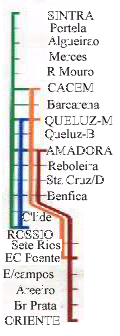
Sintra Line Services from Entrecampos-Poente, Oriente Services
towards Sintra, and the Alverca Services on the Sintra Line
Part One of the Sintra Line Page covers the route
from Lisbon's Rossio Station to Sintra. Here, in Part Two, the other stations
which are not part of the Linha de Sintra from Rossio are covered. For stations on the Alverca to Mira Sintra route, via Oriente, see the Azambuja Line Page of this site.
2: The Entrecampos-Poente Services
Prior to the temporary closure of Rossio (2004-2006?) and the revamping of Sintra Line services, a 4-trains per hour service operated along the Sintra Line as far as Cacém from Entrecampos-Poente station in northern Lisbon. These services were quaintly known as the "família de Cacém" (Cacém Family) trains. However, the service from Entrecampos-Poente now (2005) runs directly to the new station at Mira Sintra- Meleças which is just off the traditional Sintra Line, on the branch to Figueira da Foz. This is about 7km short of Sintra itself.
The Entrecampos-Poente platforms are now connected by a moving walkway from Entrecampos main station. After passing through Sete-Rios, this line joins the former Rossio line just before Benfica station.
An Alverca-Queluz service also used to run but is now cut back to Mira Sintra; these services run from Oriente via Braço de Prata, Marvila, Chelas and Areeiro to Entrecampos.

 ENTRECAMPOS-POENTE (0km)
The train leaves Entrecampos Poente (Entrecampos West) in a westerly direction and
heads off to the right along a four-track section, under a flyover. To the left
of the platforms is the Hotel Zurique and the Hospital do Rego. Almost
immediately, to the right, are sidings used by Metropolitano de Lisboa stock
and nearby is the Metro station of Laranjeiras.
ENTRECAMPOS-POENTE (0km)
The train leaves Entrecampos Poente (Entrecampos West) in a westerly direction and
heads off to the right along a four-track section, under a flyover. To the left
of the platforms is the Hotel Zurique and the Hospital do Rego. Almost
immediately, to the right, are sidings used by Metropolitano de Lisboa stock
and nearby is the Metro station of Laranjeiras.
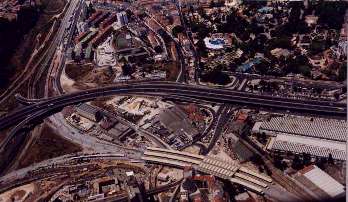
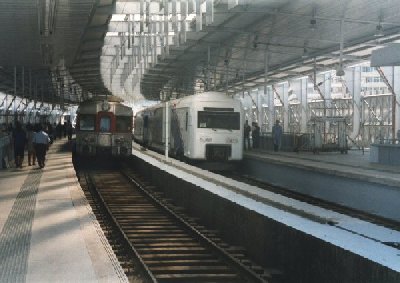
L to R: Sete Rios station (cream roof), seen from the air, 1 July 1999, with the Lisbon Zoo to its north (top, centre); a traditional CP EMU and a Fertagus double-deck EMU stand side by side at Entrecampos.

 SETE-RIOS (1km)
This recently rebuilt station has a platform/ two tracks/ platform/ two tracks/ platform lay out (P2P2P). It is a modern station at whose western end (left) can be seen a stretch of the Lisbon aqueduct, built in the 18th century. Modern flats adorn the view to the right, whilst the left, as the station is left towards Sintra is more open, with scrubland. Sete Rios is the
location of the Lisbon Zoo and there is also a nearby link to the Metro system at the Jardim Zoológico station. After Sete-Rios the train stops in the main part of Entrecampos station, before passing Entrecampos Poente and joining the Cacém-bound services before Benfica (see above). Before Benfica look to the left and you will see the impressive Palácio dos Marqueses da Fronteira before passing the large Instituto Militar army complex.
SETE-RIOS (1km)
This recently rebuilt station has a platform/ two tracks/ platform/ two tracks/ platform lay out (P2P2P). It is a modern station at whose western end (left) can be seen a stretch of the Lisbon aqueduct, built in the 18th century. Modern flats adorn the view to the right, whilst the left, as the station is left towards Sintra is more open, with scrubland. Sete Rios is the
location of the Lisbon Zoo and there is also a nearby link to the Metro system at the Jardim Zoológico station. After Sete-Rios the train stops in the main part of Entrecampos station, before passing Entrecampos Poente and joining the Cacém-bound services before Benfica (see above). Before Benfica look to the left and you will see the impressive Palácio dos Marqueses da Fronteira before passing the large Instituto Militar army complex.
3: The Lisboa Oriente Services
Sintra Line services can also be caught at Oriente station; these are trains emanating from Alverca which currently (2005) only go as far as Mira Sintra and not SIntra itself. Lisboa Oriente station is some 8km to the north east of the city centre but is handily reached by Metro, though there is a long walk between the Metro and main line station. Along with Oriente, the other stations on this line which are not used by the former Rossio or Entrecampos-Poente services are described below:

 LISBOA ORIENTE (0km)
See above for details of this striking station. To the left can be seen
the Parque das Nações, the former site of the
Expo 98 events. The train sets off south, towards Lisbon and after passing through a concrete-sided cutting a gas works on the left, and run-down housing, the
train enters...
LISBOA ORIENTE (0km)
See above for details of this striking station. To the left can be seen
the Parque das Nações, the former site of the
Expo 98 events. The train sets off south, towards Lisbon and after passing through a concrete-sided cutting a gas works on the left, and run-down housing, the
train enters...

 BRAÇO DE PRATA (3km)
This station (P2P2P) is the first stop after Oriente for services to Queluz and Sintra and it incorporates an overbridge into its newly completed structure. To the right there is light industry and new construction work as the line turns virtually towards due west.
BRAÇO DE PRATA (3km)
This station (P2P2P) is the first stop after Oriente for services to Queluz and Sintra and it incorporates an overbridge into its newly completed structure. To the right there is light industry and new construction work as the line turns virtually towards due west.

 MARVILA (4km) This is a small, graffiti-ridden halt (P2P)which has new platforms and shelters but little else to sommend it.
MARVILA (4km) This is a small, graffiti-ridden halt (P2P)which has new platforms and shelters but little else to sommend it.

 CHELAS (5km) This is a staggered halt which, like Marvila, is not very salubrious. Again the new platforms and shelters have been prey to graffiti vandals. The twin-tracked lines pass under a viaduct carrying a short, open-air section of the Red Line Metro out of Olaias.
CHELAS (5km) This is a staggered halt which, like Marvila, is not very salubrious. Again the new platforms and shelters have been prey to graffiti vandals. The twin-tracked lines pass under a viaduct carrying a short, open-air section of the Red Line Metro out of Olaias.

 AREEIRO (6km)
Areeiro (P2P1) is little more than two canopies and since 1999 it has decayed markedly, now being overrun by weeds in parts. To the left is the respectable area of Areeiro. On leaving the station, the train follows a shallow cutting, with the Hotel Lutécia to the right on the Avenida Frei Miguel de Contreiras. The Praça de Areeiro is about five minutes away to the left and has a Metro station as well as nearby bus terminal. To the right is the Roma district and Metro station.
AREEIRO (6km)
Areeiro (P2P1) is little more than two canopies and since 1999 it has decayed markedly, now being overrun by weeds in parts. To the left is the respectable area of Areeiro. On leaving the station, the train follows a shallow cutting, with the Hotel Lutécia to the right on the Avenida Frei Miguel de Contreiras. The Praça de Areeiro is about five minutes away to the left and has a Metro station as well as nearby bus terminal. To the right is the Roma district and Metro station.
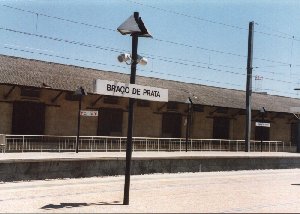
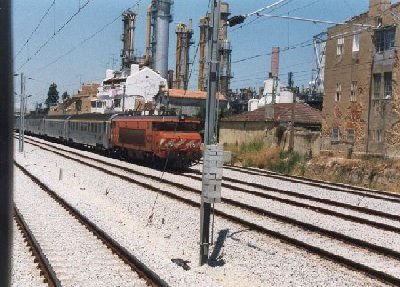

Left to right: Braço de Prata station; a Class 2600 service near
Braço de Prata, 29 June 1999; Entrecampos station.

 ENTRECAMPOS (8km
from Oriente)
ENTRECAMPOS (8km
from Oriente)
This station has recently been extended and rebuilt; it now spans not only the full width of the Avenida da República but also the Avenida 5 de Outubro, to its west. Since 1999 its importance has increased as Fertagus cross-Tagus services currently terminate here and a few CP trains from south of the Tagus call on their way to northern Portugal. CP uses the left-side of the station and Fertagus, the right. For the continuation of this route, see Sete Rios, above.
Tickets
Although all stations have staffed ticket offices, there is a grwoing number of
automatic ticket machines. These are quite sophisticated pieces of apparatus
which take a wide combination of coins and notes, give change, and allow booking to
an extensive range of stations.
Rolling Stock
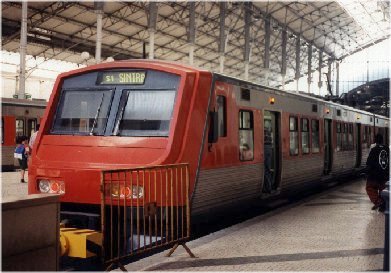
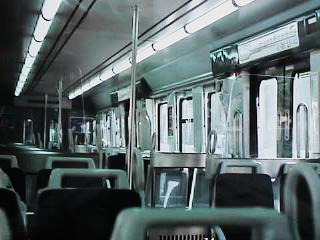
Left:A Sintra-bound ADtranz EMU waits at Rossio, 1991; right: Inside
a Class 2400 unit
ADtranz four-car EMUs, built at the Sorefame works at Amadora, were the staple rolling stock on the Rossio services and these comprise two coupled four-car units. They comprise classes
2300 and 2400, the latter being air-conditioned. The stock has attractive green upholstery and fittings, with seats for the disabled distinguished by their red fabric. Clear route maps are posted in the carriages and electronic displays alert users to each forthcoming station. Flooring is in non-slip grey plastic. The units on the Entrecampos-Poente route have opening windows, whilst those on the Oriente link are generally older Sorefame EMUs.
Copyright: ©
Contact: the following is not a link; please transcribe the address into your email 

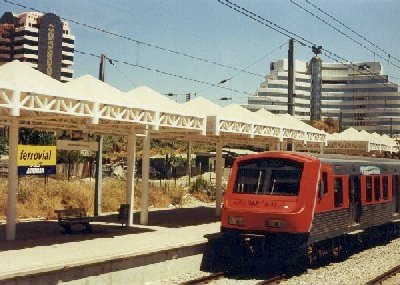
 8 April 2005 (partly updated)
8 April 2005 (partly updated)



 ENTRECAMPOS-POENTE (0km)
The train leaves Entrecampos Poente (Entrecampos West) in a westerly direction and
heads off to the right along a four-track section, under a flyover. To the left
of the platforms is the Hotel Zurique and the Hospital do Rego. Almost
immediately, to the right, are sidings used by Metropolitano de Lisboa stock
and nearby is the Metro station of Laranjeiras.
ENTRECAMPOS-POENTE (0km)
The train leaves Entrecampos Poente (Entrecampos West) in a westerly direction and
heads off to the right along a four-track section, under a flyover. To the left
of the platforms is the Hotel Zurique and the Hospital do Rego. Almost
immediately, to the right, are sidings used by Metropolitano de Lisboa stock
and nearby is the Metro station of Laranjeiras.


 SETE-RIOS (1km)
This recently rebuilt station has a platform/ two tracks/ platform/ two tracks/ platform lay out (P2P2P). It is a modern station at whose western end (left) can be seen a stretch of the Lisbon aqueduct, built in the 18th century. Modern flats adorn the view to the right, whilst the left, as the station is left towards Sintra is more open, with scrubland. Sete Rios is the
location of the Lisbon Zoo and there is also a nearby link to the Metro system at the Jardim Zoológico station. After Sete-Rios the train stops in the main part of Entrecampos station, before passing Entrecampos Poente and joining the Cacém-bound services before Benfica (see above). Before Benfica look to the left and you will see the impressive Palácio dos Marqueses da Fronteira before passing the large Instituto Militar army complex.
SETE-RIOS (1km)
This recently rebuilt station has a platform/ two tracks/ platform/ two tracks/ platform lay out (P2P2P). It is a modern station at whose western end (left) can be seen a stretch of the Lisbon aqueduct, built in the 18th century. Modern flats adorn the view to the right, whilst the left, as the station is left towards Sintra is more open, with scrubland. Sete Rios is the
location of the Lisbon Zoo and there is also a nearby link to the Metro system at the Jardim Zoológico station. After Sete-Rios the train stops in the main part of Entrecampos station, before passing Entrecampos Poente and joining the Cacém-bound services before Benfica (see above). Before Benfica look to the left and you will see the impressive Palácio dos Marqueses da Fronteira before passing the large Instituto Militar army complex.
 LISBOA ORIENTE (0km)
See above for details of this striking station. To the left can be seen
the Parque das Nações, the former site of the
Expo 98 events. The train sets off south, towards Lisbon and after passing through a concrete-sided cutting a gas works on the left, and run-down housing, the
train enters...
LISBOA ORIENTE (0km)
See above for details of this striking station. To the left can be seen
the Parque das Nações, the former site of the
Expo 98 events. The train sets off south, towards Lisbon and after passing through a concrete-sided cutting a gas works on the left, and run-down housing, the
train enters...
 BRAÇO DE PRATA (3km)
This station (P2P2P) is the first stop after Oriente for services to Queluz and Sintra and it incorporates an overbridge into its newly completed structure. To the right there is light industry and new construction work as the line turns virtually towards due west.
BRAÇO DE PRATA (3km)
This station (P2P2P) is the first stop after Oriente for services to Queluz and Sintra and it incorporates an overbridge into its newly completed structure. To the right there is light industry and new construction work as the line turns virtually towards due west.

 MARVILA (4km) This is a small, graffiti-ridden halt (P2P)which has new platforms and shelters but little else to sommend it.
MARVILA (4km) This is a small, graffiti-ridden halt (P2P)which has new platforms and shelters but little else to sommend it.



 ENTRECAMPOS (8km
from Oriente)
ENTRECAMPOS (8km
from Oriente) 

